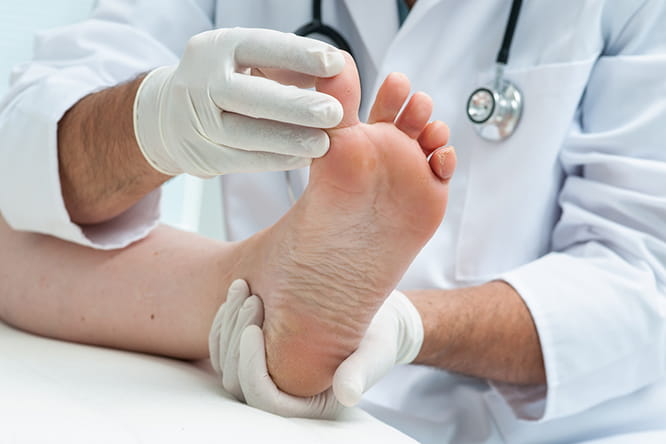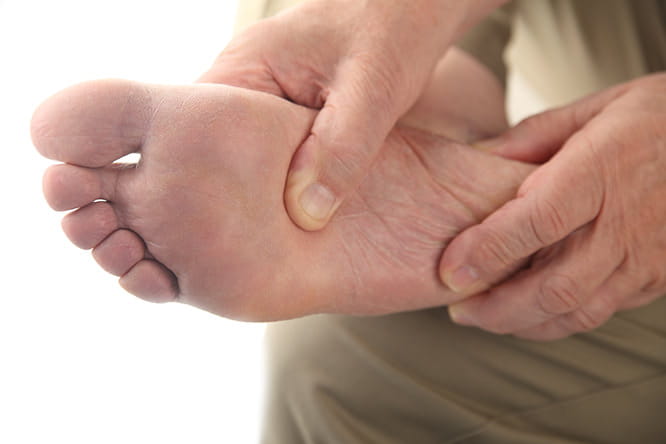Wondering about your health? Take a look at your feet.
We depend on them every day, but often, we take our feet for granted unless they hurt. A closer look at our feet can help us take care of health issues that we might not otherwise notice. Some say it just takes a 10-second check to determine if someone is healthy or may have health problems.
So when your feet send you a warning sign, don’t ignore it.
Toes turning upward may be caused by a serious lung disease, heart disease or Crohn’s disease. If you notice this condition, contact your health care profession to see what is causing this.

Swelling in your feet or ankles may indicate high blood pressure. Swelling may also indicate the existence of a severe illness such as congestive heart failure, kidney failure or liver failure If your feet and ankles swell, you should check it out.
If you have cold feet you may have a circulation issue or a thyroid problem. Cold feet may be a sign of peripheral vascular disease, poor blood circulation or a thyroid condition. Cold feet are usually more common in women than in men, because women naturally have a lower core body temperature. However, if you are over 40 and you feet are perpetually cold, you may want to have your thyroid checked. The thyroid is a gland that regulates body temperature and metabolism. If your feet are always cold, you should mention that to your health care provider.
Sores that won’t heal may be related to diabetes. In the course of walking, we can bruise our foot, create blisters or stub and scrape our toes. Usually, the injury hurts initially, then heals. But, when the sore doesn’t heal, it is a concern. Sores that do not heal on the feet may indicate elevated blood sugar levels caused by diabetes. If you have a sore on your foot that does not heal, you need to see your health care professional as soon as possible.
Numbness or tingling may indicate diabetes. This unpleasant pins and needles sensation is a sign of peripheral neuropathy, or damage to the information system transmitting information to the brain and spinal cord. It can result from diabetes, alcohol abuse and chemotherapy. See your doctor right away if you have this sensation.
Hair loss, patchy spots or changes in nail or skin color may indicate poor circulation. You’ve lost the hair on your toes. While that may cause reason for rejoicing on one side, it should cause concern. Circulation problems can be caused by arteriosclerosis. If you aren’t growing hair on your toes and you used to do that quite well, look for a pulse in your feet. If it is hard to find, contact your health care provider.
Your foot cramps or spasms may signal dietary deficiencies, overwork or something more serious. Your diet may lack calcium, potassium or magnesium, or it may be a sign that have exercised too much and you are slightly dehydrated. In some cases, the cause may be due to a brain or nerve condition.
Sore toe joints may be indicative of rheumatoid arthritis. Sore joints may be signaling rheumatoid arthritis (RA). This degenerative joint disease often attacks the smaller joints in the hands and feet first. Women are four times more likely to suffer RA than men. If not treated, RA can cause permanent deformity.
Pitted toenails may signal arthritis or psoriasis. Little holes in the toenails may be a sign of psoriasis or psoriatic arthritis. If treatment begins early, this disease can be controlled.
Dry, flaky itchy skin is a sign of athlete’s foot. If you experience this condition, don’t ignore it. You may have picked up athlete’s foot fungus. Not treated, the dry flaky irritated skin that usually starts between the toes can progress to inflammation and blisters. It can also spread to other areas of the body.
Toes that turn white and feel numb are symptomatic of Raynaud’s disease. Raynaud’s causes the blood vessels to overreact. Often people who have this malady report that their fingers or toes will turn white, feel numb, turn blue and then red before returning to a natural skin color. The cause of Raynaud’s disease is still a mystery, though it is most common in women who live in colder climates. It can also be triggered by stress.
Foot pain may be telling you to lose weight, signal the onset of arthritis or result from a stress fracture. The more weight that we carry, the more pressure we put on our feet, which can cause pain. Arthritic conditions can also make your feet susceptible to pain.
Stress fractures in the foot can make walking extremely painful. Stress fractures are most commonly caused by osteopenia, which is low bone density. Ostepenia is one of the main causes of stress fractures in women over the age of 50. Sometimes, stress fractures are caused by a vitamin D deficiency.
If it hurts to walk, don’t wait. See your health care provider. A few simple tests can determine the cause and treatment plan and help you start the healing process.
Look at your toenails. If they have pale and sunken or spoon shaped areas this may indicate anemia, which is caused by a lack of hemoglobin in the blood. If your nails look like this and you are tired, irritable, short of breath and have problems concentrating, you may want to contact your health care provider and ask him if you should have a blood test. Anemia is usually treated with iron supplements and diet.
Pay attention to your feet. Treat them well. They may have something to tell you about your health.
For more information about keep your feet healthy, visit the American Orthopaedic Foot & Ankle Society.

